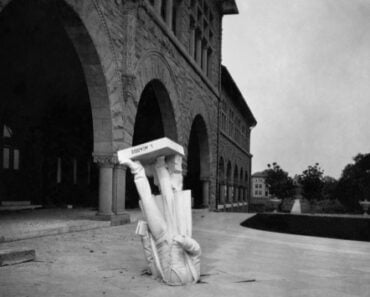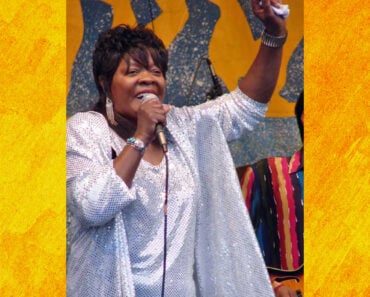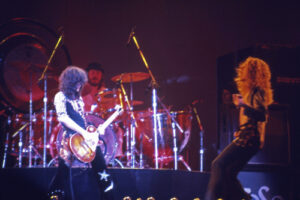
Photo: Ralf Schulze (rs-foto.de) cc-by-sa [CC BY-SA 3.0 (https://creativecommons.org/licenses/by-sa/3.0) or CC BY-SA 3.0 (https://creativecommons.org/licenses/by-sa/3.0)], from Wikimedia Commons
Uriah Heep’s origins can be traced to the late 1960s London rock scene, where the ambitious guitarist Mick Box and vocalist David Byron began working together in the band Spice. Seeking a more distinctive identity and sound, they transformed Spice into Uriah Heep in late 1969, taking their name from a character in Charles Dickens’ David Copperfield. With the addition of Ken Hensley on keyboards, Paul Newton on bass, and Alex Napier on drums, the band set out to create music that blended the power of hard rock with the nuance of progressive and symphonic influences—a combination that would soon become their signature.
The band’s debut album, …Very ‘Eavy …Very ‘Umble, was released in 1970. From the outset, Uriah Heep’s music stood apart, integrating dynamic organ and guitar interplay with Byron’s soaring vocals. Tracks like “Gypsy” introduced listeners to the band’s signature sound, characterized by dramatic arrangements and an adventurous spirit. The album garnered attention in the UK and Germany, laying the foundation for their growing international reputation.
In 1971, Uriah Heep quickly followed up with Salisbury, a record that showcased their willingness to experiment on a grand scale. The sixteen-minute title track, featuring a brass section, revealed a band unafraid to blur the lines between rock, classical, and jazz. The album also produced the single “Lady in Black,” which became an enduring classic, especially in Germany where it topped the charts years after its release. That same year saw the arrival of drummer Ian Clarke, who contributed to the band’s increasingly powerful sound.
The release of Look at Yourself later in 1971 marked another creative leap. The album’s title track remains one of Uriah Heep’s best-known songs, while “July Morning” stands as a staple of their live performances. The band’s early ’70s period was defined by rapid output and musical evolution, as they balanced hard-hitting rock numbers with sweeping, multi-part epics that highlighted their instrumental prowess.
Uriah Heep achieved global recognition with Demons and Wizards (1972) and The Magician’s Birthday (1972), both of which saw Gary Thain join on bass and Lee Kerslake on drums—forming what many consider the classic lineup. The single “Easy Livin’” from Demons and Wizards became their first major hit in the United States, peaking at number 39 on the Billboard Hot 100, and propelled the band to arena headliner status. This era solidified their reputation in Europe, North America, and Japan, establishing Uriah Heep as one of the pioneering acts in hard and progressive rock.
Throughout the 1970s, the band maintained a relentless recording and touring schedule, releasing albums like Sweet Freedom (1973), Wonderworld (1974), and Return to Fantasy (1975). Despite lineup changes—including the departures of Thain and Byron—Uriah Heep continued to build a loyal fan base. The arrival of John Wetton and later Trevor Bolder on bass, and John Lawton on vocals, introduced new textures to the group’s sound, while the albums Firefly (1977), Innocent Victim (1977), and Fallen Angel (1978) kept them relevant on the international scene, especially in Germany and Eastern Europe.
The 1980s brought new challenges and changes, as the band weathered shifting musical landscapes and more lineup turnover. Despite this, they released a series of albums—Conquest (1980), Abominog (1982), and Head First (1983)—that introduced the band to a new generation of fans, with “That’s the Way That It Is” earning airplay in the US. Mick Box remained the consistent driving force, leading the group through eras of transformation.
Uriah Heep’s reputation for dynamic live performances and their ability to adapt musically has kept them relevant for over five decades. Their touring schedules have taken them to all corners of the globe, including landmark concerts behind the Iron Curtain in the Soviet Union—making them one of the first Western rock bands to play there. Their global appeal has been further cemented by a prolific live album output and special anniversary releases that revisit their classic material.
The band’s longevity is reflected in their extensive discography, which as of 2023 comprises 25 studio albums, including celebrated later releases like Sea of Light (1995), Wake the Sleeper (2008), and Living the Dream (2018). Each new record has demonstrated their ongoing creative vitality, blending classic Heep trademarks with contemporary influences. Their music has consistently featured Mick Box’s expressive guitar work, lush vocal harmonies, and a keen sense for dramatic, melodic songwriting.
In terms of chart success, Uriah Heep found their strongest foothold in continental Europe—especially Germany, the Netherlands, and Scandinavia—where albums like Innocent Victim and Abominog achieved gold and platinum sales. While major industry awards have eluded them, the band’s influence is deeply felt among fellow musicians and fans alike. Their impact can be heard in the work of later metal and progressive acts who have cited Uriah Heep as a foundational inspiration.
The band’s members have also contributed to the wider music community. Ken Hensley, in particular, embarked on a successful solo career and wrote songs for other artists after his tenure with Heep. Former bassist Trevor Bolder joined David Bowie’s Spiders from Mars and later became a mainstay in the reformed Heep lineup. Drummer Lee Kerslake, meanwhile, contributed to Ozzy Osbourne’s seminal solo albums, further highlighting the reach of Heep alumni.
Beyond the stage and studio, Uriah Heep has been active in charitable work, supporting causes ranging from children’s hospitals to disaster relief. They have often used their platform to promote music education and access, giving back to the communities that have supported them for decades. The band’s annual Heepvention fan conventions have brought together fans from around the world, highlighting the lasting bonds their music has fostered.
Uriah Heep’s continued relevance can be attributed to their unwavering commitment to innovation and their loyal relationship with fans. Their willingness to evolve while maintaining the spirit of their classic sound has kept their concerts and albums vital. The band’s legacy is built not only on hit singles and album sales, but also on a reputation for resilience, musical risk-taking, and a deep connection to their audience.
Today, with Mick Box still at the helm, Uriah Heep stands as one of the most enduring acts in rock. Their influence echoes through the decades, and their catalog remains a touchstone for anyone exploring the crossroads of hard rock, progressive, and melodic music. Whether for their early progressive epics or their arena-ready rockers, Uriah Heep’s story is a testament to the lasting power of creativity and collaboration.
With such an extensive catalog, any top 10 list will only scratch a small surface of the band’s material.
# 10 – Gypsy
What better way to open our top 10 Uriah Heep songs list than with a song from their debut album? The excellent track “Gypsy” was released in 1970 on the …Very ‘Eavy …Very ‘Umble album. The band’s debut album featured musicians David Byron on lead vocals, Ken Hensley on piano, organ, mellotron, guitar, and vocals, Colin Wood also on keyboards, Mick Box on guitars and vocals, Paul Newton on bass and vocals, and three different drummer including legendary Elton John band drummer Nigel Olsson along with drummers Alex Napier and Keith Baker
# 9 – Sweet Lorraine
“Sweet Lorraine” is one of Uriah Heep’s most loved songs by their fans. The song was released on The Magician’s Birthday album in 1972. The song broke into the Billboard Top 100 in 1972, a feat not easily achieved by most Progressive Rock bands in the United States. Listen to the way this one starts. It hits you hard and heavy instantly and never lets go of your attention; it’s simply a spectacular song, with a sci-fi-sounding guitar lick at the start and a funky riff that kicks in at the beginning of the verse.
# 8 – Lady In Black
“Lady In Black” appears on Uriah Heep’s album Salisbury. This moody song gets better and builds in intensity as it moves along. The record was released in 1971. The band toured as the opening act for Three Dog Night and Steppenwolf when the album came out. Now that’s a concert!
# 7 – Easy Livin’
Continuing our list of top 10 Uriah Heep songs, we turn to the great Demons and Wizards album. With a cover that bleeds Progressive Rock, Uriah Heep released one of the strongest albums of their career in 1972. The album cover was designed by Roger Dean, who was responsible for many of the band Yes’s album covers. Easy Livin’ was a big hit for Uriah Heep in 1972. The song reached the US Billboard Top 40. It is one of the band’s most recognized songs.
# 6 – Bird Of Prey
“Bird of Prey” is the opening track from the band’s 1971 album Salisbury. The song featured Mick Box on lead guitar, David Byron on lead vocals, Ken Hensley on organ, Paul Newton on bass, and Keith Baker on drums. The opening guitar lick at the song’s start is to die for. This song sounds like a cross between Queen and Black Sabbath. However, as this came out years before the first Queen album, it’s easy to see that Uriah Heep influenced Queen’s music. I love that organ riff in the middle of the song.
# 5 – Look At Yourself
The Uriah Heep song “Look At Yourself” was the title track to the band’s third album, also titled Look At Yourself. The record was released in the fall of 1971. It was the band’s third studio album, recorded during the spring of 1971 at Lansdowne Studios in London. Produced by Gerry Bron, the song captures the essence of early ’70s British hard rock while revealing the ambitious musical reach of the band during this period. The recording lineup for the track features David Byron on lead vocals, Mick Box on guitar, Ken Hensley on keyboards and guitars, Paul Newton on bass, and Ian Clarke on drums, with Hensley’s organ work and Byron’s dynamic vocals pushing the song into anthemic territory. The song “Look At Yourself” was released as a single and remains one of the band’s most popular songs.
# 4 – Rainbow Demon
Our favorite Uriah Heep song from the Demons and Wizards album was the great track “Rainbow Demon.” The song served as the opening cut on side two of the album. The version presented here was a special live version that the band released on the Spellbinder Live album in 1996.
# 3 – Wise Man
ChatGPT said:
# 2 – “TIE” Stealin’ / July Morning
Two Progressive Rock masterpieces. We could not leave either one of these songs off this list, so we tied it up. Why not? The song Stealin’ was released on the album entitled Sweet Freedom. The album was released in 1973. The song “July Morning” was released on the Look at Yourself album. That album was released in 1971. We always loved the cover of the Look At Yourself album. It was just so brilliant. The song is killer. The guitar and organ work at the song’s beginning, and how the instruments dance with each other, is outstanding. David Byron delivers such a killer vocal on the track.
# 1 – Salisbury
Uriah Heep has released a tremendous amount of material over a period of close to 50 years, so we apologize if this list is heavy on early 1970’s material. We can’t help it. The material the band released early in their career is some of the best classic rock released during that era. The track “Salisbury” is all the proof you need. “Salisbury,” the ambitious centerpiece and title track of Uriah Heep’s second studio album, remains one of the band’s most striking achievements. Recorded in late 1970 at Lansdowne Studios in London and produced by Gerry Bron, the sixteen-minute epic showcases the band’s early embrace of progressive rock’s expansive possibilities. The classic lineup for this recording featured David Byron on vocals, Mick Box on guitar, Ken Hensley on keyboards, Paul Newton on bass, and Keith Baker on drums. Uniquely for a band rooted in heavy rock, “Salisbury” also features a full brass section, lending a distinctive, symphonic edge to the track’s multi-movement structure.



































